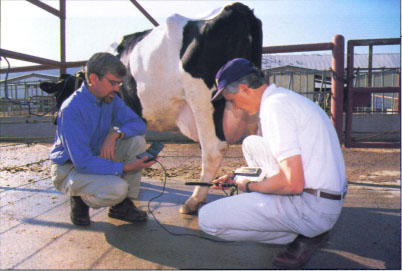All Issues
Advanced information systems to improve livestock management
Publication Information
California Agriculture 54(4):61-61. https://doi.org/10.3733/ca.v054n04p61
Published July 01, 2000
PDF | Citation | Permissions
Full text
In the 21st century, “precision farming” will improve the efficiency of livestock production as well as agricultural crops, making it possible for producers to identify and manage large animals individually even while in a herd.
In the future, individual animals will be linked to databases for improved animal selection and herd management. UC Davis animal science professors Juan Medrano and Ed DePeters identify a cow by scanning a microchip embedded in its leg.
Improvements in information resources and technology include advances in computer hardware such as increased internal data storage and portability (e.g., CD-ROM) and processing capacity, new software for decision support systems, and the World Wide Web with its incredible collection of data.
Online sensors of animal physiological attributes will continue to be integrated with these tools for better-automated livestock management systems. For example, national species-specific databases have been developed to support decision-making by farmers and ranchers and those who work with them in educational, consultation or service capacities (Oltjen 1998; Kunkle and Troxel 2000). Distributed via CD-ROM and the Web, these comprehensive databases for beef, sheep, pigs and other animals provide electronic collections of peer-reviewed and expert-selected educational materials, lists, software tools and other decision aids.
Further, the Web will continue to increase its usefulness, supplying marketing information, facilitating direct-marketing, and allowing two-way communication between livestock consultants and producers. These tools are already bringing useful information to the farms, homes and offices of livestock producers operating in even the most remote rural communities.
In the future, individual large animals will be linked to specific databases, allowing for improved animal selection and herd management. Such systems are already a legal requirement in the European Economic Community and are widely used by dairy producers in many other countries. The National Cattlemen's Beef Association (1999) has called for a voluntary program in the United States to utilize tracking and database technology to enhance food safety, provide information for better management and improve product quality and industry profitability.
When such systems are in place, the interdependence of all segments of the livestock industry becomes apparent. Several private companies have introduced databases which allow all participants in livestock production systems, from providers of animal genetics to sellers of consumerready products, to capitalize on information to solve complex industry-wide problems as well as those of individual producers and firms.
Historically, change has occurred slowly on small farms and in the developing world. But with access to the Web and advanced information resources, there is no reason why the lack of knowledge should limit technological progress in livestock production.





